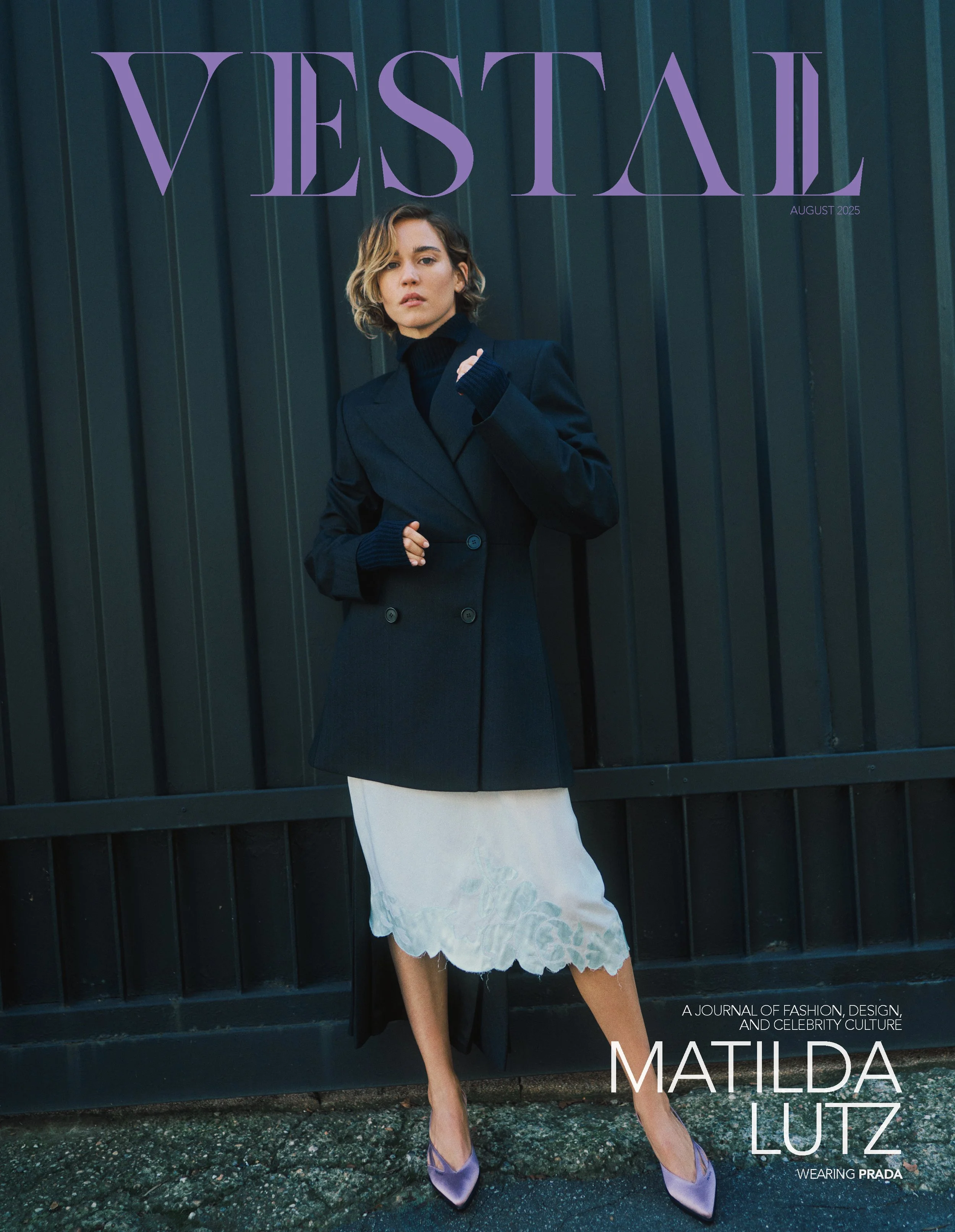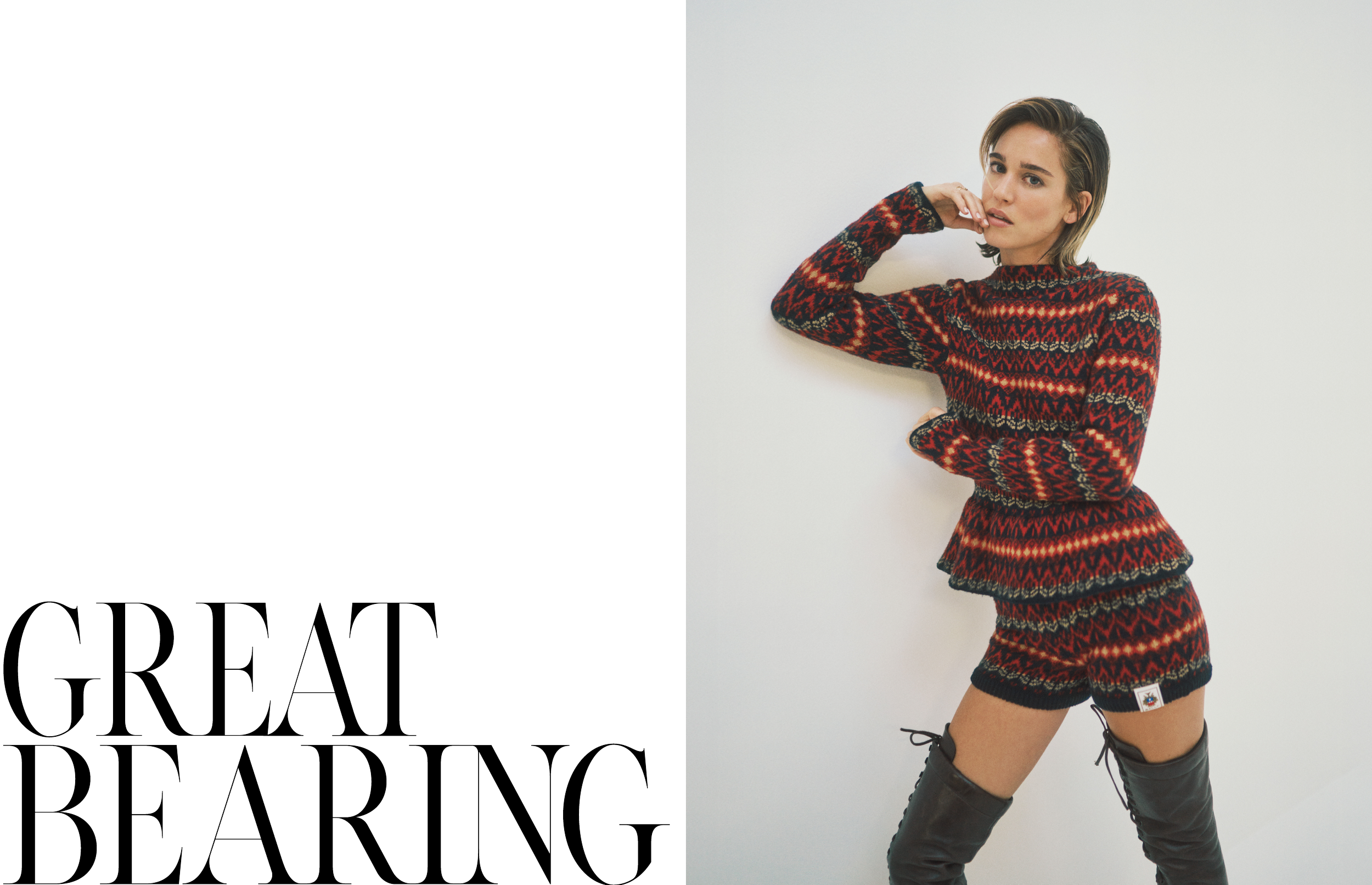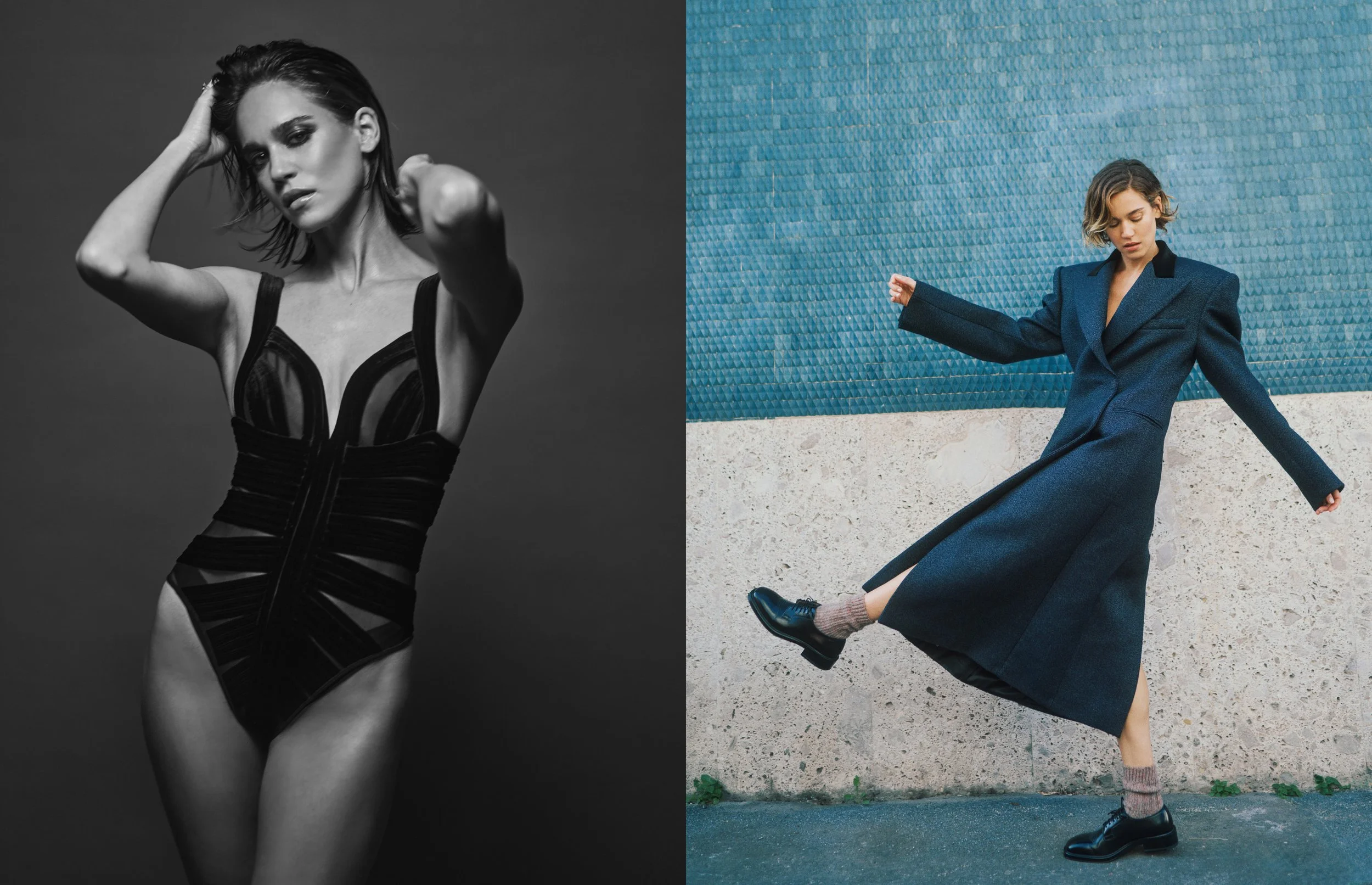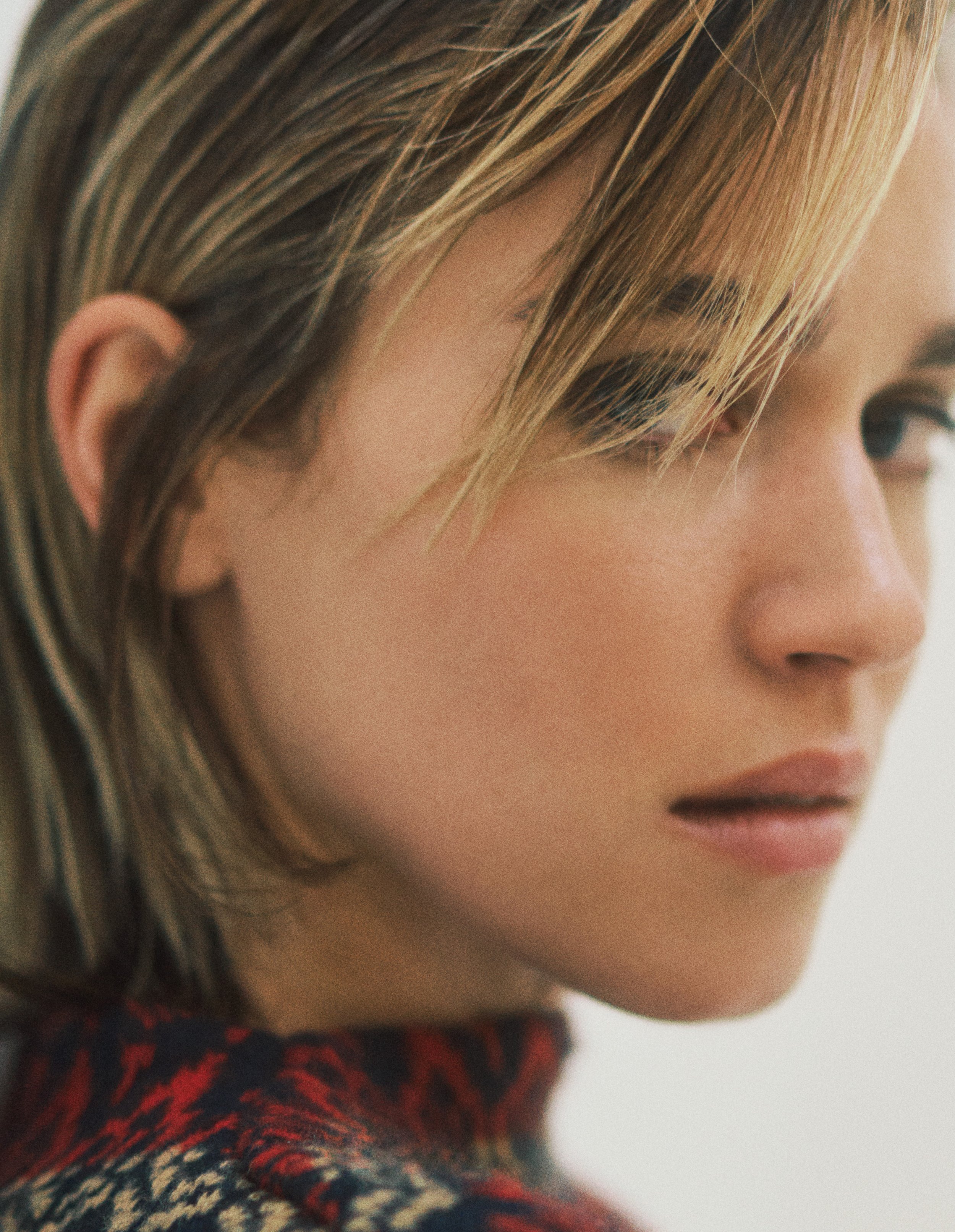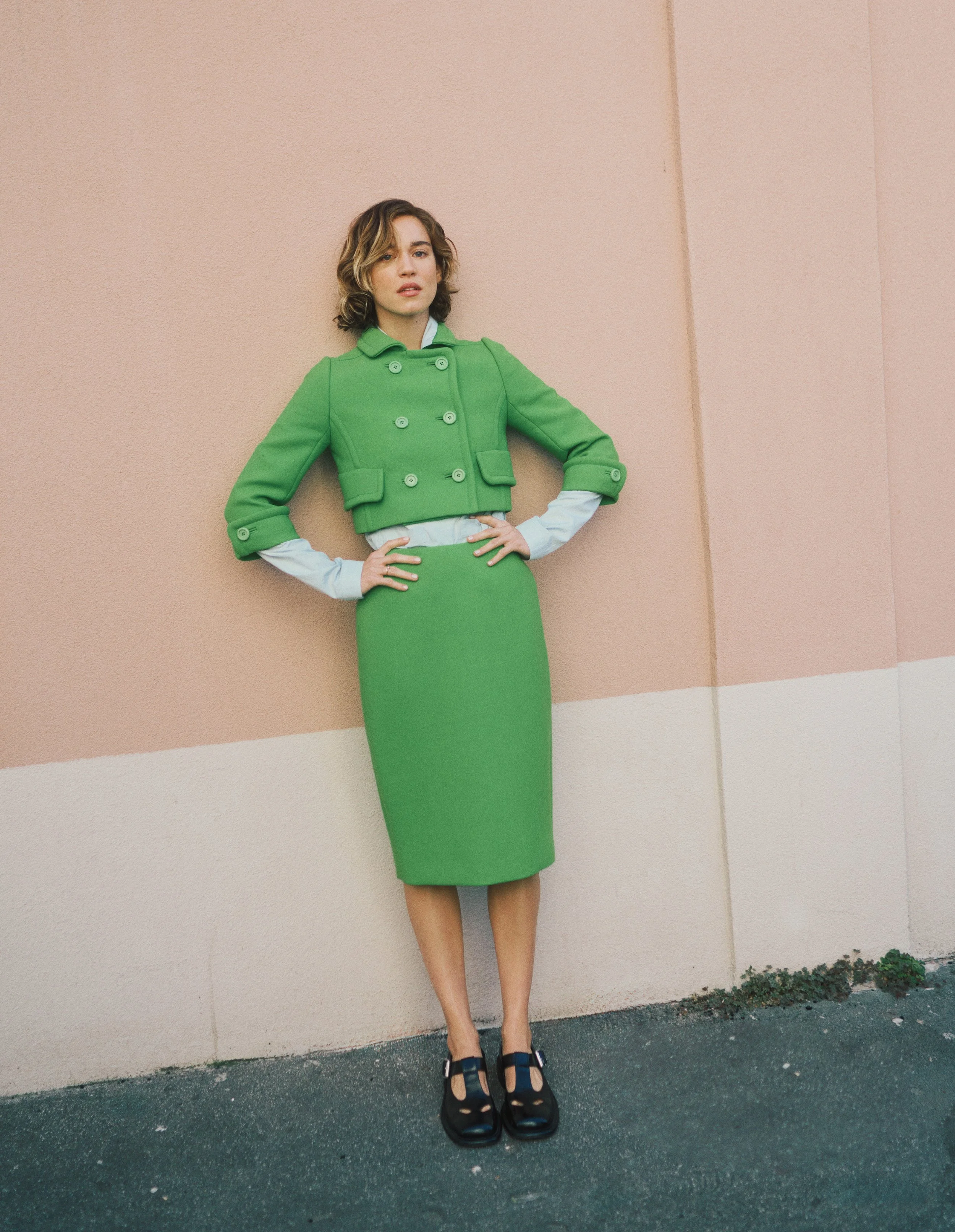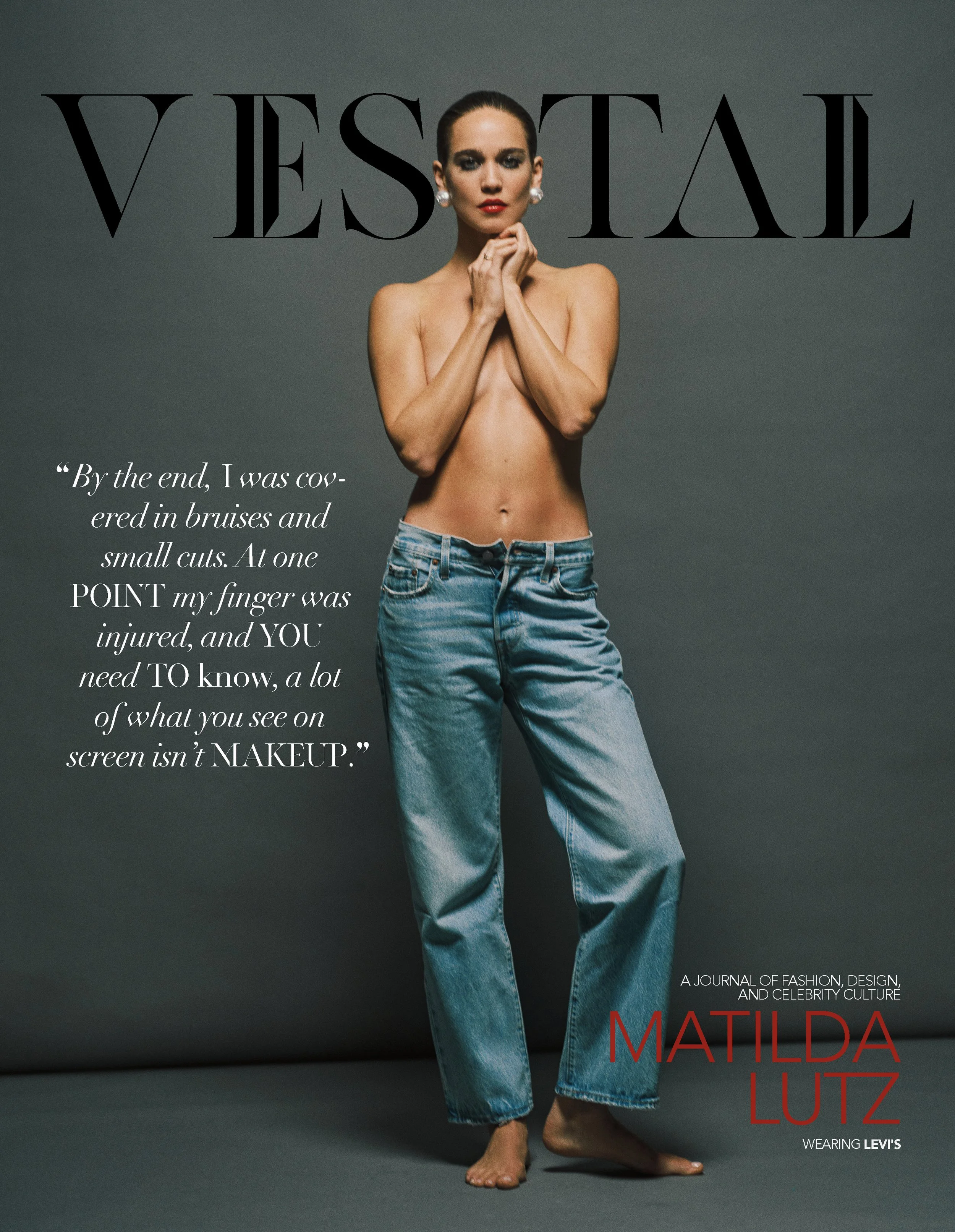AUGUST 2025
WEARING PRADA
A warrior forged in pulp and fantasy, Red Sonja has long existed at the intersection of spectacle and strength, unapologetically bold, impossibly fierce, and often caught between icon and caricature. But in her latest cinematic incarnation, directed by M.J. Bassett, there’s a shift.
Not a reinvention that turns its back on the past, but one that sharpens it. The world is still wild, the battles still bloody, but this Sonja feels more grounded. Less distant myth, more physical force. Less untouchable icon, more woman who fights and bleeds. Italian-American actor Matilda Lutz takes on the legend with a performance built not on volume or bravado, but on the weight of history, loss, and survival. Yes, the swordwork and stunts are awesome, but what she brings to the character is something quieter: an internal gravity, a tempered fury, a tenderness that refuses to disappear. Matilda has long gravitated toward roles that blur the line between pain and resilience. In her breakout performance in Revenge, she fused ferocity with vulnerability, turning survival into a story of tenacity and strength. With Red Sonja, she goes further. The character has lived on the page for nearly fifty years: fierce, fiery, and often flattened by the genre that created her. But here, in Matilda’s portrayal, Sonja becomes more than iconography. She becomes flesh and spirit. A woman who has already lost everything and still chooses to protect what’s left. This isn’t nostalgia. It’s reinvention.
Total look BALLY.
PHOTOGRAPHY PAOLO SANTAMBROGIO
STYLING SELIN BURSALIOGLU
INTERVIEW DAVID GARGIULO
David Gargiulo __ You’ve lived between cultures: Italian, American, and French. Do you feel like you belong to one place more than another, or do you exist somewhere in between?
Matilda Lutz __ I'm still trying to figure it out. Basically, I grew up with an Italian mom and an American dad, in a really small town near Milan, like 2,000 people small. We were “the Americans” there, even though I was born and raised in Italy. Then, when I got older, I’d visit the States once a year because my dad moved back there when I was six. And in the US, I was “the Italian.” So I always felt like I never truly belonged anywhere. That really bothered me when I was a kid because you want to belong, you want to be part of a group and I never felt like I fit in. It was different with France. I was older when I started spending time there, and all of a sudden, I wasn’t “the American” or “the Italian.” That gave me a sense of belonging I hadn’t felt before. Over time, I started seeing this in-between identity as a gift. The fact that I had an American dad and Italian mom, I was bilingual, and able to live in the States or in Italy. The clash of cultures made me feel like a citizen of the world. But I only started appreciating it when I got older. When I was little, it just felt confusing and frustrating.
DG __ I can relate as I come from a similar background. I think that’s pretty common for kids growing up between cultures. Where did you study in Italy or the U.S.?
ML __ I was born and raised in Italy, and I did all of my schooling there up until high school. If you can believe it, I went to a science-focused high school. Then after high school, I went to New York for a year because I was so confused about what I wanted to do with my life. I wanted to take time to explore, try new things. After that, I went back to Italy and studied psychology for two years in Milan. In the meantime, I started acting. In Italy, especially if you don’t have any connections in the industry, it feels unrealistic. Like, people ask, “Okay, but what do you really do?” Acting still felt like a dream, not a career. So I had that mindset: I loved it, but I didn’t think it could actually become my job. I was studying psychology and doing acting courses on the side. Then I started working, found an agent, and realized it could be a career.
Bodysuit TOM FORD. ( opposite ) Total look SPORTMAX.
DG __ So you started with math when you were really young, then switched to psychology, and finally found your way to acting.
ML __ Yes. And I think it all helped me in the end. Everything I’ve done in my life has shaped the woman I am today. And honestly, it gave me discipline. This job is very artistic and creative, but it also requires a business mindset and structure. The schools I went to were really demanding, and I feel like that gave me a strong foundation. It helped me push through when things got difficult.
DG __ Since you spent so much time in Italy, what’s something Italian that’s still part of your everyday life?
ML __ Cappuccino and cornetto ai frutti di bosco [ed. wild berry croissant] in the morning. Like a real Italian, I need my coffee in the morning. [laughs]
DG __ Do you see yourself in the characters you play, or do they exist in a separate space for you?
ML __ I always try to find myself in them somehow. I build my characters both from the outside in and the inside out. It usually starts with imagery, photos, songs I come across that I feel the character would listen to, or that put me in the right emotional state. I collect references. Sometimes I’ll see a newspaper article and cut it out. I keep everything in a notebook that I create specifically for each character. Even the notebook itself, the kind I choose, is important. I include anything that inspires me: films I watch, people I see on the street, even something as small as a flower. It all goes into the notebook. And as I gather those pieces, I start asking questions: When does my character laugh? What makes her cry? What makes her dance? What makes her feel alive? As I explore those questions, I naturally start to find similarities between myself and the character. It’s something I realized while studying psychology, and also through the process of building roles. Every character is different, they have different backgrounds, they walk and talk differently, but the human condition is universal. Pain, loss, love, those things connect us all. So, if I can tap into my own experiences and bring that emotional truth to the character, even if she’s totally different from me, it makes the performance feel more grounded.
DG __ You mentioned that you built a soundtrack around your character. What music does Red Sonja listen to?
ML __ For Red Sonja, there was this one song I listened to a lot. It’s called Òran an Ròin by Julie Fowlis. It’s very mystical. You can hear the forest in the background, all these layered natural sounds. It has this Celtic, Irish kind of feeling. That’s the world I imagined Sonja in: very spiritual, very in tune with nature and her goddess. So I gravitated toward music that could put me in a meditative state, something that helped me feel connected to the earth and to that deep sense of inner power.
DG __ Going back to human emotion and everything you bring into a role. Red Sonja is a story of empowerment. What did stepping into her boots and wielding her sword teach you about your own strength?
ML __ A lot. But I think the biggest thing I took with me is that I’ve always been very apologetic in my life. I’ve often apologized for being too loud, too much, too opinionated. But Red Sonja is not. She doesn’t apologize for taking up space. She doesn’t ask permission. And after filming, I noticed myself standing taller, not being afraid to speak up, not holding back my opinions. That was something powerful for me.
DG __ That must have been liberating. The character Red Sonja has existed in comics, pulp novels, and a cult classic film. As an actor, did you take inspiration from any one version?
ML __ So I actually haven’t watched the 1985 film which is the only previous film adaptation of Red Sonja. And that was a conscious choice. First of all, I didn’t want to mimic someone else’s version of her or have that performance stuck in my head. But also, from the very beginning, our director, MJ [Bassett], told me not to watch it. Even before I got the role, during the process for the audition, she said, “Please don’t watch the film. I want this to be something completely new.” I did read some of the comics. There are a lot of issues, but I got a few from Luke Lieberman, who owns the rights to Red Sonja. The artwork was actually a huge inspiration. Even though it’s just drawings, the details helped me start shaping the character early on. But I also didn’t want to rely too heavily on that, since she's not a living person. So I took it in, let it sit in the back of my mind, and then let it go. Later, when I was preparing more deeply, I looked at other references. I watched Milla Jovovich in The Fifth Element because she has that wild, untamed energy I wanted Sonja to have. I also watched a lot of Vikings, because the fight scenes in that series are some of the best. Same with Braveheart and Gladiator, films that could give me visual and emotional references for combat and character intensity. Most of the preparation was physical: stunt training, sword fighting, all of that. But I also wanted to have strong visual references in my head for the mood and movement of the character.
DG __ Was there a fight scene you felt especially proud of?
Total look TOM FORD. ( opposite ) Total look MIU MIU.
ML __ It’s hard to pick just one. One day I’d be fighting 10 soldiers, the next I’d be galloping on a horse and shooting arrows, or climbing a 12-meter wall. It was so much fun! There is one scene, though, that stands out. It’s probably the most iconic: I’m in the chainmail bikini, which is the legendary Red Sonja’s look, and I’m in an arena fight surrounded by 300 extras, the full cast, and 200 crew members. I was fighting armored soldiers while basically wearing nothing for protection. When I tried that bikini on during fittings, I thought, “This is going to be tough.” And the director, MJ [Bassett], didn’t want to shoot the fight in fragments. She wanted to film the choreography from beginning to end, in long takes, so no cutting away, no shortcuts. So we repeated the full two-to-three-minute fights again and again. By the end, I was covered in bruises and small cuts. At one point my finger was injured, and you need to know, a lot of what you see on screen isn’t makeup. [laughs] But despite the pain, it was so empowering. Red Sonja defeats all these men in full armor, while she’s wearing a bikini. It was liberating and symbolic in a way that went beyond just the choreography.
DG __ That sounds amazing. Tell me more about the other stunts.
Total look MIU MIU.
ML __ I love sports, and I genuinely enjoy doing stunts, so I was really committed. But I had never done horseback riding or sword fighting before, so I had to start from scratch. With horses, there’s a lot of improv. They’re large beautiful living beings, so they react to sounds, movement, energy, and they're incredibly powerful. At first, I was shocked at how difficult it was. You see those dreamy Instagram videos of people galloping on the beach and think, “I can do that.” But the reality is very different! I trained really hard. I wanted everything to feel natural, not like I was acting like a warrior, but actually becoming one. One part of the training that really shaped me was something called “Liberty training,” where you work with the horse without a saddle, reins, or anything, just pure connection. I had to develop a relationship with him so strong that I could guide him with nothing but subtle gestures. For example, I’d tap him gently on the front leg, and he would kneel down and lie down with me. No commands, no tools, just trust. We even trained for a scene where I’m lying next to him, asleep, and then I wake up in a forest. It was a real forest, full of sounds and movement, and any small trigger could have startled him. After filming, the stunt team told me that what I had just done was actually one of the most dangerous things to attempt. If the horse had gotten spooked and stood up suddenly, it could have gotten messy. But we had such a strong bond that he felt safe with me, and I felt safe with him. It was magical.
DG __ That’s such a powerful connection. Did you get to keep the horse?
ML __ I wish! His name is Carlitos. My big love. He’s in Spain, but I still keep in touch with the stunt team. I ask about him all the time. Honestly, he gave me so much, and I’ll never forget that experience.
DG __ Sounds like the perfect excuse to take a trip to Spain. [laughs]
ML __ Exactly! And from Italy, it’s not that far. [laughs]
DG __ Let’s talk about Sonja’s evolution. How did you bring pieces of yourself into her journey on screen?
ML __One of the main things I wanted to bring to her was vulnerability. When you first hear about Red Sonja, you think, “she’s a warrior, she’s strong, she’s wild.” And yes, she is all of that, but I didn’t want her to just be tough and unbreakable. I wanted her to feel layered. And vulnerability is something I’ve never been afraid of in real life. It felt important to bring that into her character. She loses everything and still finds a way to fight, not just for herself, but for the people and creatures she loves. She’s always thinking about others, always showing compassion, even toward animals. There’s so much humanity in her.
DG __ If Sonja were real and alive in 2025, what kind of world do you think she would demand?
ML __ I think the film is very contemporary. We shot it two years ago, so none of the current issues were being talked about quite as much yet, though they were already happening. But now, it feels even more relevant. What you see in the film is exactly what she stands for: she doesn’t believe in greed or selfishness. She believes that in order to live in this world, we need to work together. We need to finally understand that we are all one. That’s what Sonja’s fighting for and honestly, it’s also what I want for the world.
DG __What’s something you’re secretly really good at and not many people know?
ML __There are two things I’d say. One is singing. I’m really shy about singing in front of people, so it’s not something everyone knows about me. And the second thing is making tiramisu. I’m not good at cooking in general, but my tiramisu is amazing.
DG __Yum! Love tiramisu! When you're watching yourself on screen, what are you looking for?
ML __ It's a very love-hate relationship. Especially when I first started acting, I was miserable watching myself. I remember most of the films I’ve seen were at the premieres, because I didn’t get a chance to watch them beforehand. And I just wanted to sink into the chair, dig a hole, and disappear. It was really hard. You do a project, you act in it, and then it takes at least a year, sometimes two, before it gets released. And by then, you’ve grown so much as an artist, as an actor, even as a woman. Watching something from two years ago, it’s like seeing a version of yourself that doesn’t exist anymore. It’s strange. I don’t like it because I’ve grown past that version of myself. But it’s getting better now. I’ve started to see the other side of the coin. I watch myself with more curiosity like, “What can I learn from this? What would I do differently next time?” It’s more like studying now. I notice what I’d keep, what I’d change, and I try to look at it more like an audience member. Also, I’d love to direct one day. And now when I watch a film, I notice everything! The framing, the soundtrack. Sometimes I wish I wasn’t in the industry, just so I could actually enjoy movies without analyzing them.
Makeup CHANEL BEAUTY. ( opposite ) Total look BRIONI.
DG __What’s a lesson or truth that keeps finding its way back to you, no matter where life or work takes you?
ML __ My acting coach told me years ago: “Every time you leave a room, don’t think about what you did wrong. Think about what you learned.” That stuck with me. It applies to everything, auditions, work, relationships. So many actors beat themselves up when something doesn’t go the way they hoped, but I’ve come to believe that everything happens for a reason. And if you can treat every experience as a lesson instead of a regret, it changes how you move through life. Especially in relationships, whether it’s a breakup, a divorce, the end of a friendship, if you can look at it as something you needed to learn, it’s no longer a loss. It’s part of your growth. I believe people come into your life to teach you something about yourself, or about the way you live. And when they leave, it doesn’t mean it was wasted. It means it added something to who you are. So I think that’s the lesson that keeps showing up for me, over and over again.
Photographer Paolo Santambrogio, Stylist Selin Bursalioglu, Interview David Gargiulo, Hair and Makeup Loris Rocchi using Chanel Beauty, Actor Matilda Lutz (Shafran PR)
IN THEATERS
Wearing LEVI’S


